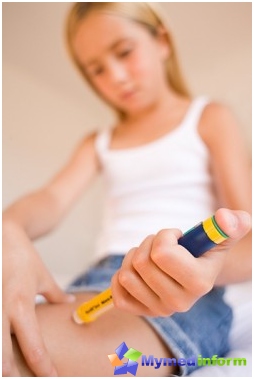What do we know about insulin?

So that the person felt cheerful and full forces, the body needs to be constantly «recharge», splitting glucose into components. So the energy charge is needed for good well-being. The most affordable essence of diabetes can be characterized as follows: The disease develops when the body is unable to recycle glucose decay products.
Insulin produces a special group of pancreas cells - Langerhans islands. This substance supplies glucose directly into the cage, where it is converted into energy. Insulin quantitative indicators are not static, they change very quickly - almost every minute. Factors affecting the production of this substance a lot. For example, when a person eats something, the insulin level rises, and during sleep, on the contrary, decreases. Also, some drugs are able to reduce insulin production rates in the body.
When sugar (glucose) turns out to be in the body, in the blood there is a sharp jump in its concentration up - it should be. After some time, the pancreas islands of Langerhans produce insulin, thanks to which glucose absorbed the cells of the body, therefore, the concentration of blood sugar decreases. In general, the process of sugar processing the body spends about 2 hours. Normal glucose indicators under which insulin is not produced, 3.3-5.5 mmol / l.
What is diabetes
This is chronic, very reluctant to treat, severe disease. His two types are isolated - I and II.
Children, especially small, most often suffer from diabetes I, insulin-dependent, type. With this form of the disease are affected by the responsible for the production of insulin cells. It is easy to guess what happens at this time in the body: those insulin units, which was able to produce pancreas, do not have time to dissemble sugar in purpose - a large amount of unspent glucose continues to circulate in blood.
Type II diabetes - insulin and independent. Insulin is produced as much as it is necessary, but cell receptors do not react to it and as a result are not absorbed into the blood glucose.
Why sugar diabetes appears

The per capita of parents should be the following symptoms:
- Strong thirst for reason. The kid constantly wants to drink - regardless of the season and time of day.
- The child often goes to the toilet «in small». A healthy baby pisses an average of 5-6 times a day, the number of urinary in children, patients diabetes, ranges from 10 to 20 times a day. Often observed enuresis (urinary incontinence at night). This feature of glucose is explained «attract» To your water, as a result of which the volume of urine increases, and with urine, the body allocates excess sugar.
- Dry skin, dry mucous membranes. In the body of a child due to illness focuses a large amount of water. Where she comes from? Besides the fact that the child drinks a lot, the intercellular space of the skin and mucous membranes also highlights the liquid, which first enters the blood, and then stands out with urine.
- The child wonders in weight. Cells, inconsistent with glucose, are deprived of full nutrition and energy.
- The child flies vision. Excess sugar can remain in the body not only in the form of fat - it can accumulate in the kidneys, blood vessels and lens of the eye, which is why its cloudy and visual acuity falls.
- Constant weakness and fast fatigue. The growing body is not enough energy: such children are difficult to study, they are lagging behind in physical development from peers, they often have a headache.
In infants, suspicion of diabetes can be the following features:
- Digestion Disorders - Vomiting, constipation or vice versa, diarrhea;
- anxiety;
- The child is very often sucking breasts.
Diagnosis of disease in children
- Blood analysis on sugar. The norm is 3.3-5.5 mmol / l. Indicators 7.6 mmol / l and above are talking about diabetes. If the blood glucose level is increased to 7.5 mmol / l, the child may have a hidden form of the disease.
- Glucosotolar test is used to finalize the diagnosis.
- In addition, pancreatic ultrasound is carried out to eliminate inflammatory processes in the organ.
Treatment of diabetes in children

The problem of diabetes is done by an endocrinologist. Diabetes type determines the features of its treatment.
Treatment of type I diabetes.
Almost all children suffer from diabetes of this type. In the treatment of fundamental replacement therapy: the missing amount of insulin in the blood needs to be filled.
Insulin, which is used in the pediatric practice of treatment should be non-radiated (short) action. The most suitable in this regard can be considered the preparations of Protofan and Aktropyid. They are injected subcutaneously through special syringe sticks. This form of introduction of the drug is very convenient for the child: he himself can fill the syringe, set the dose for the introduction and make yourself an injection.
Unfortunately, science has not yet developed funds for full healing from diabetes. But this is not a sentence, but rather the need for a constant parental control over the health of the kid. It is very important to organize proper nutrition for the child. Categorically refuse:
- acute and fried food;
- sweet and flour;
- pasta and some croup;
- Potatoes.
Every day, with the help of a glucometer monitor blood sugar levels.
Treatment of type II diabetes.
The child's body produces a sufficient amount of insulin, but no cells «Nothing» it is therefore the main thing in the treatment of diabetes of this type is to avoid a sharp jump glucose in blood.
To do this, completely forget about the so-called mine-friendly carbohydrates: sugar, chocolate, flour. The volume of the remaining carbohydrates is significantly cut. For convenience, food is measured by bread units. This is the amount of product containing 12 g of carbohydrates. From one bread unit, the blood sugar level rises by 2.2 mmol / l.
To keep diabetes under control, eat regularly and often - more than 6 times a day.
Diabetes warning in children

Our site is confident: even if there is no reason to fear for the health of the child with respect to diabetes (there is no genetic factor and T. D.), do not refuse prevention measures. Unfortunately, no one is insured 100% of this disease. The rules are very simple:
- Do not overeat;
- There is a flour in more than modest quantities;
- control the amount of sugar eaten;
- know about sports not by first;
- engage in the prevention of colds.









